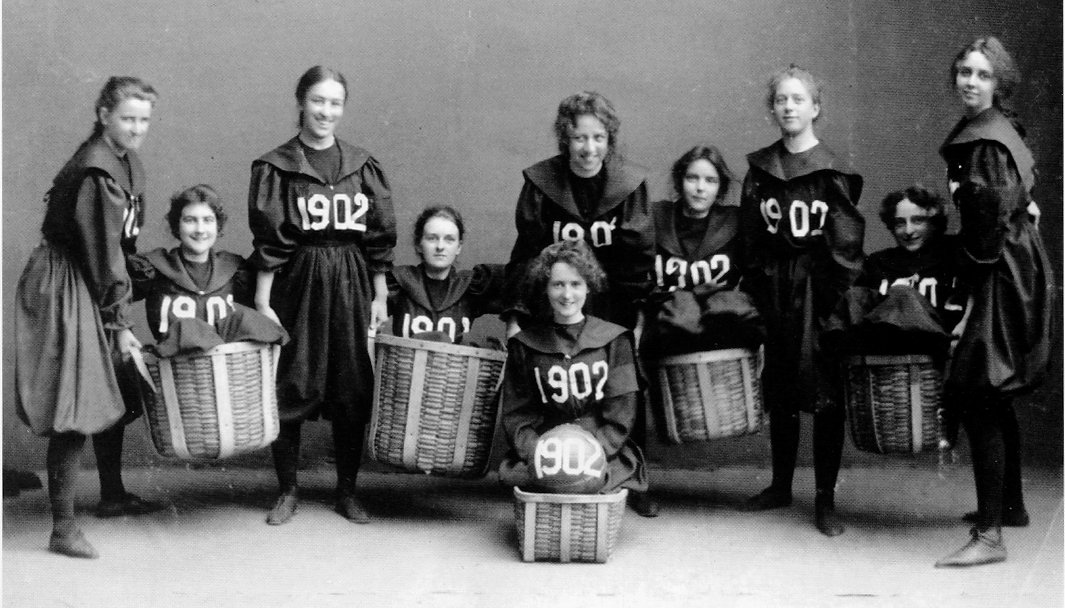McGill alumnus James Naismith invented basketball in 1891 with the overarching goal of giving his restless students something to do during a Massachusetts blizzard. After the first game, his students beat each other up in an effort to score, so he instituted the 13 original rules of the sport to prevent excessive violence while still maintaining the spirit of the game. Basketball, like all sports at the time, was designed exclusively with male athletes in mind and it spread quickly across college campuses in the United States—but it wasn’t just men who were taking up the sport.
While Naismith is rightfully crowned as the Father of Basketball, Senda Berenson Abbott respectfully earned the title of Mother of Women’s Basketball in 1892 when she introduced the game to the female students at Smith college a year after Naismith invented the sport. Abbott altered the rules slightly to make it more acceptable for ladies to play, eliminating the rougher parts of the game–like being able to slap the ball out of players hands and recentring the game on being a new form of exercise, much like simple aerobics.
While many basketball games were played by female athletes both in college gyms and in public, the first intercollegiate game officially took place in 1896, between Stanford University and the University of California, Berkeley–Stanford won 2-1. Interestingly, this matchup occurred just a year after the first intercollegiate game was played between men’s collegiate teams at Hamline University and the Minnesota State School for Agriculture, a match that Hamline won. Prior to this, most games were played between YMCA teams, an organization that adopted the game in its infancy and helped mold it into what it has become today.
The development of basketball was slow for female players primarily because it was at odds with notions of female respectability. Early players were required to wear floor-length dresses, which they would trip over, resulting in black eyes and broken bones, until bloomers were introduced to the sport in 1896. Bloomers did away with the restrictive corset and made it much easier for ladies to breathe. Some still complained that the sport was too masculine for ladies, and parents would forbid their daughters from playing—that did not stop Spalding from publishing an official rule book for women’s basketball in 1899, nor did it prevent the sport from crossing into Canada’s borders.
Women were first admitted to McGill in 1844, and by the early 1900s they formed their own women’s college, the Royal Victoria College, which welcomed its first basketball team in 1909—four years after the Executive Committee on Basketball Rules was formed by the American Physical Education Association (APEA). The team was composed of nine players, all of whom can be seen in their team photo modestly dressed in elbow-length sleeved tops and floor-length skirts—with, presumably, bloomers underneath—their official uniform. The introduction of this sport, along with many other female sports at McGill, was spearheaded by the efforts of Ethel Mary Cartwright, who in 1919 established McGill’s Department of Physical Education and devoted her life to teaching and athletics opportunities for both male and female students.
In 1920, Cartwright invited the Queen’s University women’s basketball team, under the direction of Ruth Clark, to a matchup against her team, marking the first intercollegiate women’s basketball game in Eastern Canada. McGill won the match, which was so successful on the whole that Clark and Cartwright teamed up with Marie Parks from the University of Toronto to form the Canadian Intercollegiate Women’s Basketball League. The League included their three teams plus the University of Western Ontario in London. Three years later, the Women’s Division of the National Amateur Athletic Federation (NAAF) was formed, an organization that would pave the way for multiple women’s collegiate basketball teams and players.










Pingback: More surprises along the way | Women's Hoops World